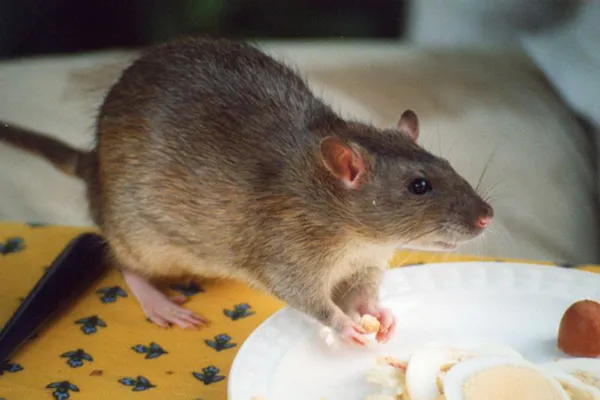The most common types of wild rats in North America include:
- Brown Rats: also known as wharf rats, or Norway rats
- Black Rats: also known as ship rats, or roof rats
- Packrats: also known as wood rats
- Marsh rice rats
Rats are extremely common animals to have near your home, and there are different species you should know about if you think you might have an infestation. Read on, and find out everything you need on the subject, as well as how to manage the problem.
Brown Rat, Wharf Rat, or Norway Rat
Among all the rat species, brown rats are the most common ones. They usually live in urban areas, which is why you might have seen them around your house or know someone who has.
Their scientific name is Rattus Norvegicus. Norway rats came from China, but now they are all over the world – basically, in any place where there are humans (except for Antarctica).
Norway rats typically have grey or brown fur with light fur on their underside. It is one of the largest species, and it can weigh twice as a roof rat and much more than a house mouse.
Additionally, brown rats are often eight to 10 inches long, while their tails are seven to 10 inches long, which makes the tail almost as big as the body. Adult males can weigh 350 g on average, whereas females are often around 250 g.
In some cases, Norway rats can weigh up to 1,000 g, but that can almost exclusively happen with house rats. Wild specimens are almost always 300 g at most. Therefore, stories with ‘rats as big as cats’ are commonly an exaggeration since most of them are considerably smaller.
Just like other rodents, brown rats can carry many diseases that are dangerous to humans, which is why rat control is so important. Unfortunately, a Norway rat specimen is part of an invasive species, and they are superb climbers and have a keen sense of smell, so only a pest control company like AAAC Wildlife Removal could help you manage the infestation properly.
A Norway rat or brown rat often lives in places like sewers and can transmit diseases such as rat-bite fever, cryptosporidiosis, Weil’s disease, hantavirus pulmonary syndrome, and hemorrhagic fever.
Even though the brown rat transmits many different diseases, domesticated Norway rats are often the pet many people choose.
Scientists can also use a brown rat as a lab rat since their physiology is ideal for many experiments. However, wild rats are still dangerous, so you should never hesitate to call and get professionals to help you if you have a rat problem.

Ship Rat, Roof Rat, or Black Rat
Adult black rats are smaller than Norway ones, as they are often between five and seven inches long. Their tails are between six and eight inches long, and they often weigh 75 to 230 g, but it entirely depends on their subspecies.
Even though black rats have a very specific name, their fur can be a different color such as light brown or grey. Furthermore, they are native from India but they now reside in every continent of the world.
Black rats are omnivores, and they are famous for being a menace to farmers because they often eat their crops. Moreover, roof rats often don’t have food preferences, so they could eat anything from swine to dog and human food.
Both black and brown rats belong to the genus Rattus, and they can live wherever humans are near. However, black rats often prefer less-populated places to live in, which is why they are not so common in urban areas.
A black rat could live in areas with many people, but they became immensely famous due to their role in the spreading of the bubonic plague. Since they deeply enjoy staying in ships, they used to live there and spread the plague among the people aboard, which is why it quickly spread throughout Europe; thus the rats’ nickname: ‘ship’ rats.
Moreover, a black rat often seeks more tropical climates. Nonetheless, there is evidence that it can survive in extremely cold weather, which shows that it can adapt to extreme conditions when they need to survive.
Black rat populations are a threat to many natural habitats, crops, and people. They carry different diseases, such as typhus, Weil’s disease, the bubonic plague, trichinosis, and toxoplasmosis. At the same time, they feed on insects, birds, human food, and agricultural-based crops alike, which makes them extremely harmful.
Although many people like having domestic rats as pets, wild black rats can carry many diseases, viruses, and bacteria. Most homeowners quickly identify a nest if they find shredded paper in secluded spaces, so you should consider that if you want to make sure you have none of these specimens at home.

Woodrats or Packrats
Also known as bushy-tailed rats or woodrats, pack rats are rodents as well, and they usually weigh between 300 g and 600 g. Adult females are somewhat lighter since their weight can vary from 230 g to 350 g, with an average of 270 g.
Packrats belong to the same species as cotton rats, which is called the rodent genus Neotoma. They have very large black eyes, a fluffy long tail, and big ears. They are extremely common in the United States and northern Mexico, as well as other parts of Central America.
Just like many other rats tend to do so, packrats build nests. They find any available debris such as sticks, twigs, and branches, which can be very dangerous. In many cases, they might get into your attic and damage electrical wiring, or they could even get into your car and do some serious harm. Overall, they wreak havoc anywhere they go, and they often make a lot of noise, so identifying them is not very hard.
A unique characteristic about these small animals is that they might drop something they’re carrying if they find something else that interests them more. At the same time, they often like shiny objects.
Other species don’t demonstrate this feature, but packrats stick to a specific habitat type that is located in their range. In other words, once they have built a nest, they often stay there for a long time.
They can eat fruits or any other type of food, and their coat is usually light brown. Overall, they might try to locate any place where they have easy access to things they can eat and steal to build their nests.

Marsh Rice Rats
Marsh rice rats are another type of rodent people might find in their homes, especially if they live in the United States. They are particularly common in Florida, and the specimens in that state often have a more reddish coat of fur.
This type of rat is very similar to black and brown ones, but the color of their fur is immensely different. Unlike the other two specimens, this one has a grey or brown underside and heads backs, and torsoes have lighter colored fur. Additionally, the feet are off-white.
On average, marsh rice rats weigh 40 to 80 g, and males are typically heavier than females. They are also nine to 12 inches in length, which makes them bigger than other species.
Unlike Norway and black ones, marsh rice ones are not that common. Scientists believe it’s due to weather conditions. Furthermore, there are often more marsh rats in the summer than in winter, though in states like Louisiana and Texas they are more stable during all seasons.
Studies done in Mississippi proved that meteorological phenomena such as rain and floods caused an immense impact on the rat population, which is why it can dramatically change from year to year.

How to Deal with Infestations
If you find rats’ nests, you might be wondering whether you have true rats at home. In many cases, you might want to take care of the situation yourself.
However, the best way to deal with a rat infestation is to get professional help. Contacting the experts at AAAC Wildlife Removal provides you with a team of people who are ready to manage your issue. Moreover, you never have to worry about using the wrong methods and suffer from a persistent rat infestation.
With AAAC Wildlife Removal, you can simply trust that the experts solve your problem as soon as possible. Once they’re at your house or place of business, they can evaluate the situation and determine the cause of your rat issue and resolve it quickly and completely.
Finding rats and managing an infestation sounds easy, but using the wrong methods can cause a lot of consequences. To avoid any unwanted and unnecessary situations, you should trust experts in the field and leave everything up to them.
Rats live near human habitations, which is why it is very common to find them at home. Therefore, you should contact AAAC Wildlife Removal to ensure you and your family stay safe at all times.
Originally published on https://aaacwildliferemoval.com/blog/rats/different-types-of-rats/





